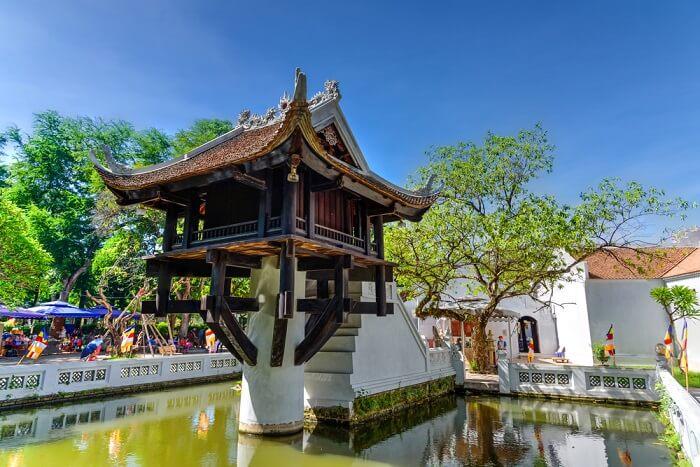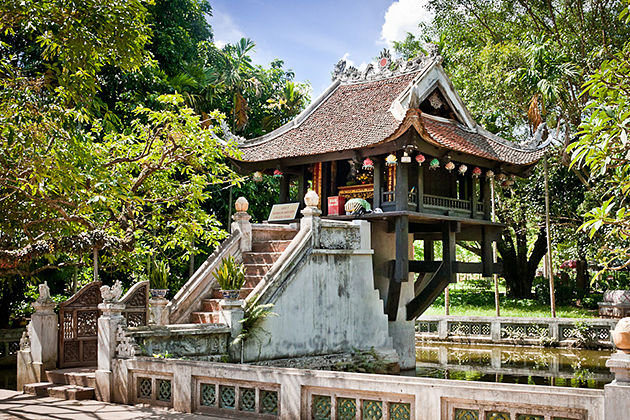
One Pillar Pagoda – the most important historical site of present-day Hanoi
One Pillar Pagoda or Lotus Pagoda in Vietnamese is often called Chua Mot Cot, located in the center of the capital. This is one of the most common symbols and the most important historical site of present-day Hanoi. Not only having a long history, the pagoda is also impressive with its distinctive style of architecture which resembles a lotus flower in bloom. For visitors to Hanoi, this is a must-see site.
One Pillar Pagoda History
One Pillar Pagoda was started building for the first time by King Ly Thai Tong in October of year 1049. According to history records, the king who at that time hadn’t had a son to succeed his throne once came to many pagodas to pray for his wish to come true. He returned and dreamt of Guan Yin sitting on a blooming lotus on a square pond. In the dream, the Guan Yin invited him to a specific pagoda in Nhat Tru village and gave him a fairy newborn. After the dream a while, the queen gave birth to a boy. The king then knew that the gods had helped him, came to Nhat Tru village and built a pagoda that has one pillar and a roof looked like a blooming lotus, named first as Dien Huu pagoda (meaning Long Happiness).
Annually, the king visited the pagoda on the 8th of lunar April to attend the Buddha Washing ritual with all monks of the capital. After the ritual, the king would stand on a pedestal before the pagoda and release a bird in the cheering of people. One pillar pagoda was restored many times by many emperors before being completely ruined in the 20th century.
In 1954, the French troops, before withdrawing from Hanoi, destroyed the pagoda by mine. After Ho Chi Minh’s government taking over Hanoi, the department of culture began to rebuild and restore the pagoda, sticking to the original state.

Architecture of One Pillar Pagoda
One Pillar Pagoda is placed in a complex with the pagoda itself, another pagoda nearby and a Tam Quan gate. The main pagoda is made of wood, with a statue of Guan Yin inside. This style of architecture already existed before the pagoda as an example of another one pillar pagoda in Ninh Binh with an 8 sided stone pillar resembling a lotus flower. Linh Chieu lake was added later in 1105 by king Ly Nhan Tong. One Pillar pagoda as you see of today is 4m high with each curved roof side is 3m wide and a single pillar 1.25m in diameter. The pillar is actually made of 2 blocks of rock. In the whole work, the roof is the most important part, especially to religious buildings. One Pillar pagoda’s roof is curved in all 4 sides and decorated with traditional patterns of two dragons facing the moon. This pattern, to Vietnamese people, symbolizes the holy power bringing the wish for wisdom and vitality of human beings. The image that the pagoda is designed of expresses perfectly a Buddhist idea of equality for all people through a lotus flower. Above all, One Pillar Pagoda, despite going through many damages and changes and destruction, still stands like a lotus flower in the city of peace which is proudly represent Vietnam country and people.
Source: asianwaytravel
RELATED POSTS:




